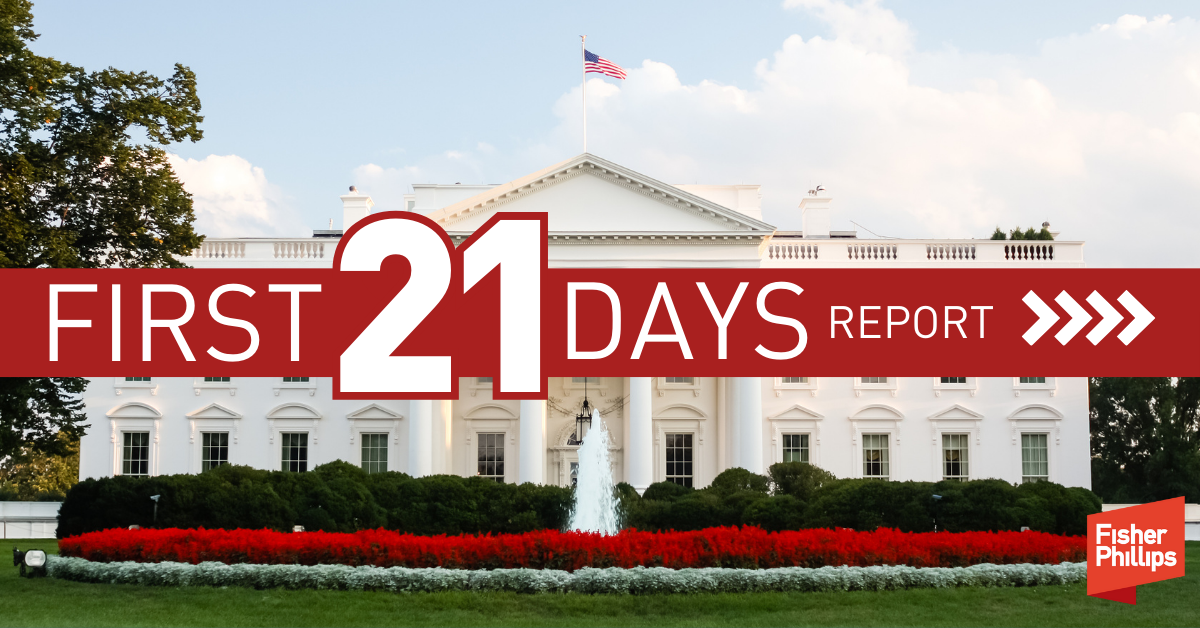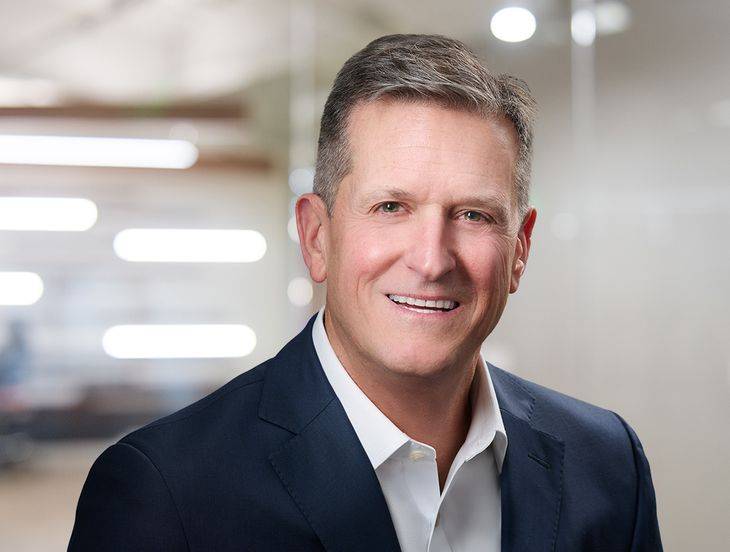A Whirlwind Start: Employers’ Recap of First 21 Days of the Trump Administration
Insights
2.10.25
President Donald Trump is just 21 days into his second term in office, but you might already be struggling to keep up with the number of changes and policy shifts coming from the new administration. While new presidents are typically judged based on their actions in their first 100 days, Trump’s whirlwind first three weeks warrant taking a pause to make sure you’re caught up on all the changes impacting key workplace issues. Major policy shifts have already affected immigration, DEI programs, equal employment opportunity, labor relations, and artificial intelligence. Here’s your 21-day recap:
1. Immigration
- What happened? President Trump took swift immigration action, signing 10 executive orders relating to immigration policy on day one. Among other things, those orders declared a national emergency at the U.S.-Mexico border, reinstated the "remain in Mexico" policy and terminated the asylum-related mobile app, and designated Mexican criminal cartels as terrorist organizations. Another one ended automatic birthright citizenship for children of undocumented immigrants, but this order has been blocked nationwide by federal judges in Washington and Maryland while legal challenges play out in court.
- Anything else? The Trump administration has begun carrying out its plans for mass deportations, which could have impacts on multiple key industries. U.S. Immigration and Customs Enforcement (ICE) has started conducting widescale enforcement activities, including workplace raids. You can click here get caught up on other recent immigrations actions already impacting employers. And K-12 schools should be prepared for ICE activity on campus and check out our school-focused Immigration Enforcement FAQs.
- What should you do? Ramp up your I-9 compliance efforts, consider using the E-Verify system, and establish a rapid response plan. Take these five steps to prepare for anticipated enforcement activities. If you are subject to a DHS raid, contact our new Employers' Rapid Response Teamat (877) 483-7781 or DHSRaid@fisherphillips.com. Work with your immigration counsel to keep up with continuing policy shifts, develop proactive compliance strategies, and consider ways to support any impacted employees.
2. Affirmative Action and Diversity, Equity, and Inclusion (DEI)
- What Happened? This January 21 executive order not only dismantled key affirmative action and DEI standards for federal contractors but also directed federal agencies to combat “illegal” corporate DEI programs (and you can click here to read how the order impacts DEI activities in K-12 schools). Days later, the Department of Labor announced it was ceasing all pending investigations and enforcement activity under the now-rescinded Executive Order 11246, which had required federal contractors to meet certain race and gender affirmative action obligations since the 1960s. A lawsuit filed February 3 alleges that Trump’s anti-DEI efforts are unconstitutional.
- What should federal contractors do? Stay tuned for more information from the Office of Federal Contract Compliance Programs (OFCCP), track legal challenges to the administration’s actions, and reach out to your attorney to develop a game plan to comply with evolving requirements. You also must continue to participate in other required compliance filings (as applicable), such as EEO-1 and VETS-4212, and state pay data reporting.
- What should employers in the private sector do? Review or assess your hiring, training, and promotion practices in light of these new federal anti-DEI initiatives.
3. “Gender Ideology” and the Equal Employment Opportunity Commission
- What happened? Within hours of taking office, Trump signed a sweeping executive order requiring the federal government to recognize only two biological sexes (male and female, as determined at conception) and removing the concept of “gender identity” from federal anti-discrimination laws – a stance that seemingly runs counter to the Supreme Court’s Bostock ruling on Title VII’s definition of “sex.” The order also calls for reversals of any policies that allowed gender-identity-based access to single-sex spaces (like bathrooms), and rescinds many Biden-era actions, including 2024 EEOC workplace harassment guidance that expanded protections for pregnant and LGBTQ+ workers. And you can click here to read about how the “gender ideology” order impacts K-12 schools.
- Anything else? Trump took the unprecedented step of firing two Democrat members of the EEOC on January 27, enabling him to quickly install a majority of Republican commissioners rather than having to wait until their normal terms expire over the next two years.
- What’s next? We expect Trump to appoint at least one EEOC replacement member so that the agency can began taking action that align with his plans. You can expect to see DEI programs on the chopping block, a rescission of the 2024 Pregnant Workers Fairness Act rules, expanded rights for religious workers, restricted approaches to gender identity and worker bathroom access, stronger “reverse discrimination” principles, and overall reduced EEOC enforcement and outreach. But you can also expect uncertainty due to the likely litigation over the two EEOC Commissioner firings and the potential for a court to strike down any steps taken by the agency in the interim.
4. Labor Relations
- What happened? In a series of swift and game-changing moves, President Trump summarily dismissed two key figures at the National Labor Relations Board (NLRB). While the General Counsel Jennifer Abruzzo’s dismissal was widely anticipated, the unprecedent firing of Board Member Gwynne Wilcox raises significant procedural and policy questions for the federal labor agency in the short term and beyond. President Trump also just appointed William Cowen as NLRB Acting General Counsel on February 3.
- What’s next? We expect that in the coming weeks and months Trump will appoint and the Senate will approve at least one more NLRB Member, though Wilcox has already launched a legal challenge to her termination. As the Board takes shape, we also expect a big shift away from its recent pro-labor stance. We expect the Board to expand employer authority over employee activities while limiting the scope of federal labor law to exclude gig workers and independent contractors. Here’s everything you need to know about the current state of the NLRB and your best practices moving forward.
5. Artificial Intelligence
- What happened? The White House enacted a sweeping shift in AI policy by rescinding President Biden’s executive order on artificial intelligence and announcing a massive private-sector-led AI infrastructure investment. The moves signal a sharp departure from the prior administration’s regulatory approach, replacing AI oversight with a focus on economic growth and national competitiveness. President Trump also appointed David Sacks as the new “AI & Crypto Czar.” Sacks – a Big Tech veteran, Silicon Valley insider, and vocal advocate for deregulation – will likely oversee a seismic transformation in how AI will be regulated and integrated across industries.
- What’s next? Employers and AI industry leaders must now deal with an evolving landscape where AI regulation is loosened and investment in AI development is skyrocketing.The emphasis will be on innovation and industry collaboration, and for employers, this means a flurry of new workplace AI tools that you’ll need to track and integrate. But you should also note that we’re starting to see a patchwork of various state and local laws regulating the use of AI in the workplace. Click here to review all of the laws, regulations, guidance documents, and court action that impact employers and their use of AI.
Conclusion
President Trump’s second term kicked off at a rapid pace, and we expect to see a lot more to come during his first 100 days and beyond. We will continue to monitor developments related to all aspects of workplace law, so make sure you are subscribed to Fisher Phillips’ Insight System to get the most up-to-date information and visit our New Administration Resource Center for Employers to review all our thought leadership and practical resources. If you have questions, contact your Fisher Phillips attorney.
Related People
-
- Benjamin M. Ebbink
- Partner
-
- Rick Grimaldi
- Partner
-
- Lauren Laing
- Legal Content Counsel



